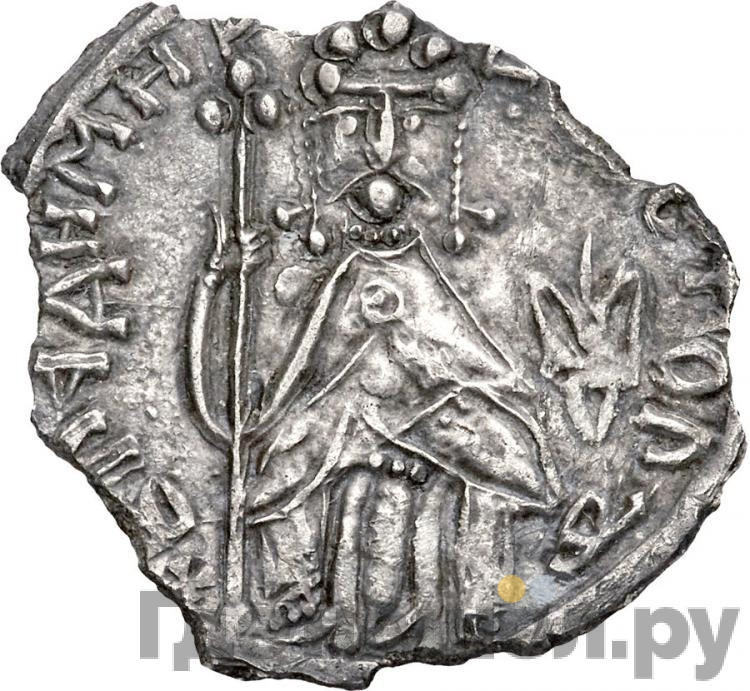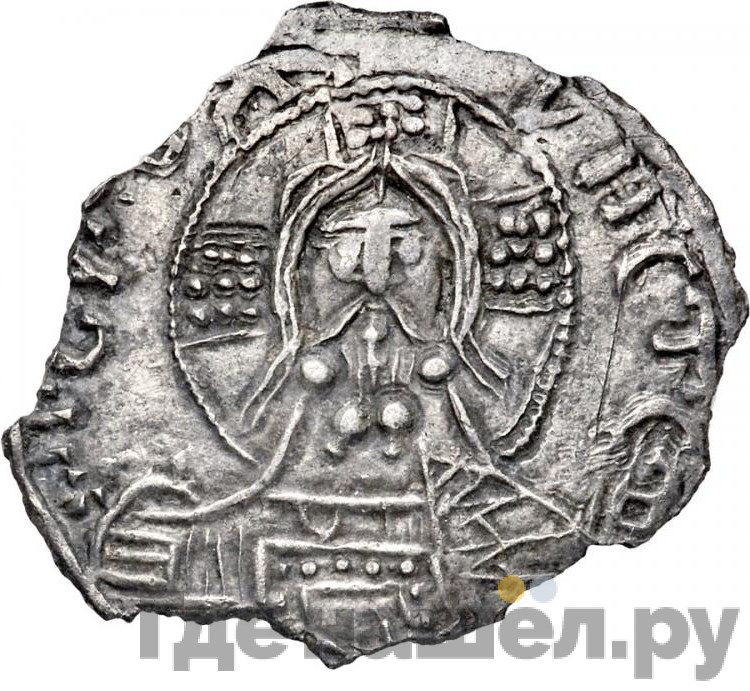Heritage Auctions, Inc. Signature Auction - Chicago #3073 Лот №31714


Аукцион: Heritage Auctions, Inc. Signature Auction - Chicago #3073
Лот: 31714
Завершен: 29.04.2019
| Стартовая цена: |
64 556 RUB
1 000 USD |
| Цена продажи: |
216 909 RUB
3 360 USD |
Grand Principality of Kiev. Vladimir I, the Great (980-1015) silver Srebrennik ND XF (scratch, edge chips), S&S Type I, 12-1 (same dies). 24mm. 2.22gm. Obv.: Enthroned figure of Grand Prince Vladimir in Byzantine-imperial dress with crown facing, tall cross-topped staff in right hand, pulling left towards chest; trizub to right; legend around reads Vladimir na stole ("Vladimir on the throne") in old cyrillic / half figure of Christ Pantocrator facing with nimbus cruciger, wearing extra curly beard, book of Gospels in left hand held to chest; legend around reads Vladimir, a se yego srebro ("Vladimir, and this is his silver"). An absolutely mint example of this extremely rare type of the first ruler of Kiev-Rus to be baptized, struck much nicer than most examples on a characteristically chipped flan. All of the details are remarkably deeply impressed with only the slightest traces of weakness in the design--an astonishing feat for these typically crude coins--the distinction between Vladimir's fingers, crown, and ornaments firmly defined and fully rendered. The script of the legends moreover appears refined and fully literate, with only a slight scratch extending downwards from the C to the right of Christ's bust. Established along the bustling trade routes linking the Byzantine Empire, Islamic World, and the Nordic lands, the early Viking settlement of Kiev-Rus was well-positioned at the crossroads of a vast monetary trade, though the Rus themselves initially possessed no minting tradition of their own. This fortunate geography not only brought them into contact with the Byzantine international gold coin par excellence, the histamenon nomisma, but also with an enormous volume of Arabic dirhams flowing out of the Abbasid Caliphate to Eastern Europe and Scandinavia. While this flow had reached its height in the eastern Slavonic lands around the 9th century, by the closing decades of the 10th a dearth of silver hand become apparent in the Islamic world, bringing the export of dirhams to the West to a halt. It has been supposed by numerous scholars of early Russian numismatics (including Spassky) that this crisis of silver coin--the production of Byzantine silver in the form of miliaresia at this time also being largely minimal--in Slavic trade prompted Vladimir I to strike his own coins, the so-called srebrenniki (whose name literally means "silver") to try to supply for the earlier trade. Though the designs of these coins are clearly inspired by the nomismata of Basil II and Constantine VII, with the image of a seated imperial figure and the bust of Christ, their weight and fabric trace much more heavily from the broad, thin Arabic dirhams so prevalent in the 8th and 9th century trade, further evidence that the new coins were conceived to replace the old. Another, parallel possibility for their production was Vladimir's capture of the Byzantine mint city of Korsun around 990, which up to that point had been the only mint operating in Byzantine territory besides Constantinople. While the Grand Prince returned the city to the Eastern Emperors not long afterwards (as the bridegroom's gift for his marriage to the Emperor's sister Anna), it is highly likely that he brought minting officials together with priests and relics with him back to Kiev. Regardless of the foundational impetus, the srebrenniks seem to have failed at their initial goal, for after brief periods of production under Vladimir's sons Svyatopolk the Accursed and Yaroslav the Wise, Rus entered a centuries-long coinless period. At the time that I. G. Spassky's The Russian Monetary System was published, the number of known srebrenniks of all three rulers numbered only in the low 20s. Both the presence of clear Christian symbolism and the truly masterful level of execution on the present piece reveals interesting facts about its history, clearly struck after Vladimir's momentous baptism in 988, with the style and literacy of the legends pointing to an early period of manufacture in the series. For the collector and scholar of the early history of the Russian state alike, such an offering presents a unique opportunity not-to-be-missed.HID05401242017